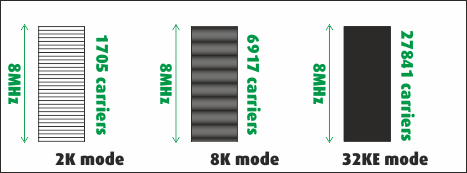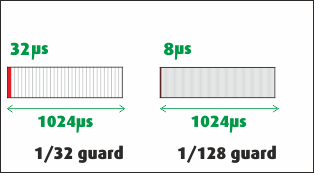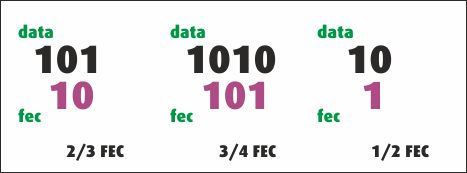Freeview modes - a simplified explanation
 Brian Butterworth published on UK Free TV
Brian Butterworth published on UK Free TV As mentioned in How digital television works Freeview signals can be broadcast in a number of different "modes", which are a combination of five parameters. Some of these have changed over the years because the increase in computing power has made more efficient methods of broadcasting cheap enough to fit in a set-top box - it is now possible to broadcast high definition television or more standard definition services on the same physical wavelength.
As some of the ideas that are implemented would fill a text book by themselves, I have presented the concepts in a simplified way.
Sub-carriers
Each Freeview multiplex is broadcast within an 8MHz channel that was originally allocated to analogue television. Rather than being a single broadcast, the channel is split into a number of different signals that sit next to each other.The original digital terrestrial broadcasts (from the launch of ONdigital) used 1,705 sub signals (referred to as 2k mode) about 4,600 Hz apart. After switchover 6,817 subcarriers (8k mode) means the signals are 1,170 Hz apart, with the high definition service using 27,841 (32ke) subcarriers just 280Hz apart.

It is possible to space carriers so close together because they are carrying digital information, in the analogue domain the problem with sidebands would render a similar system useless.
Symbol duration
For reasons detailed below, the information is not transmitted in single bits on each carrier, but as groups of bits which are referred to as "symbols". Each symbol is held in the transmission system for a given duration, 1024 us. The longer this time is, the less information is carried, but too short a duration for each symbol would not allow the receiver to detect the information correctly.Guard interval
Each subcarrier also uses a guard interval, which turns off each carrier as part of the transmission cycle. With SD broadcasts, this is 1/32th of the symbol time (32us), on HD it is 1/128th (8us). The guard intervals start each symbol and exist to deal with the problems of multipath - where the signal is being received directly and also by reflections.
Forward error correction
In non-synchronous digital transmission systems, such as those used for the internet, the presence of data corruption between the sender and receiver can be signalled back to the source and the data resent.However, a digital broadcast is a one-to-many unidirectional system, with no ability to ask for data to be resent.
For this reason, the transmissions use "forward error correction", which is a system that allows a certain level of errors to be detected.
The most basic form of a forward error correction (FEC) would be to transmit each bit twice - as long as each bit was sent along a separate subcarrier, then a single bit loss on one carrier could corrected by using the one sent on the other carrier. However, this is very inefficient, as it reduces the useful capacity of the system by half.

So, instead the DVB-T system uses a Punctured Convolution coding system. Instead of sending each bit twice, bits are grouped and then a code that describes the bits in a way that a single bit error can be detected and corrected most of the time.
Quadrature amplitude modulation
In the above descriptions, the word "symbol" was used to describe what is transmitted. You may have thought that a digital system would transmit information on the subcarriers as bits. However, doing this in a broadcast system is actually unproductive.For this reason, quadrature amplitude modulation is used. This takes the incoming bits and encodes them in groups. The most basic form encodes bits two at a time, using sine (Q) and cosine (I) functions that are then added to the main carrier. In effect "00" is encoded as -Q-I, "11" as +Q+I, with "01" and "10" being +Q-I and -Q+I.

At the next level, as used for DVB-T, the bits are encoded in groups of four bits (16QAM) or eight bits (64QAM), with DVB-T2 being groups of 16 bits (256QAM).
UK Freeview modes
There are 10 modes defined for use in the UK, these are:- Mode 1: DVB-T 1705 (2K) carriers, 64QAM mode, FEC=2/3, 1/32 guard = 24.13Mbps
- Mode 2: DVB-T 1705 (2K) carriers, 16QAM mode, FEC=3/4, 1/32 guard = 18.1Mbps
- Mode 3: DVB-T 6817 (8K) carriers, 64QAM mode, FEC=2/3, 1/32 guard = 24.1Mbps
Mode 4: DVB-T2 6913 (8KE) carriers, 64QAM mode, FEC=4/5, 1/32 guard = 34.7MbpsunusedMode 5: DVB-T2 27841 (32KE) carriers, 256QAM mode, FEC=3/5, 1/128 guard = 36.1Mbpsunused- Mode 6: DVB-T2 27841 (32KE) carriers, 256QAM mode, FEC=2/3, 1/128 guard = 40.2Mbps
- Mode 7: DVB-T 6817 (8K) carriers, QSPK mode, FEC=1/2, 1/32 guard = 6.0Mbps
- Mode 8: DVB-T 6817 (8K) carriers, 64QAM mode, FEC=3/4, 1/32 guard = 27.1Mbps
"high capacity commercial multiplex mode". Mode 9: DVB-T2 27265 (32KN) carriers, 256QAM mode, FEC=3/5, 1/128 guard = 35.2Mbpsunused- Mode 10: DVB-T2 27265 (32KN) carriers, 256QAM mode, FEC=2/3, 1/128 guard = 39.2Mbps
- Mode 11: "Northern Ireland mode" details TBC
Diagram showing capacity for each mode:

Help with Television sets?
Saturday, 10 August 2019
C
Chris.SE12:53 AM
MikeP:
I don't know if you saw this page Changes to the Freeview channel line-up in Cumbria, south west Scotland and the south Lakes | Freeview not that it solves your reception issue. I'm surprised that there is that much difference in signal between the SDN mux on C23 and the BBC HD mux on C22, espeially as the SDN mux is transmitted at lower power.
Worth checking first, you don't have any boxes with an RF output that is using one of the lower channels? If so, retune it so that it uses one somewhat above say C37.
I assume you carried out a full retune? Sometimes boxes and sets get in a confused state after retunes so it may we worth doing the following -
Unplug the aerial and do an automatic retune which should clear all previous tuning and channels as there is no signal. Then plug the aerial back in and do a manual tune for each of the UHF channels allocated to each multiplex.
If the issue still persists, do you have a wideband/group T aerial? If so it's possible that your received signal is right on the digital "cliff-edge" and you might be better off with a dedicated Group A aerial which has higher gain than a wideband and slightly less "drop-off" at the bottom end. You'd be best talking to a reputable LOCAL TV aerial engineer, one that's been recommended and not one that just installs "contract" aerials.
| link to this comment |
C
Chris.SE12:54 AM
That previous post was for Gilbert Wright: and not MikeP: , apologies for the typo!
| link to this comment |
Monday, 3 February 2020
M
mike mclaren3:45 PM
Living in the DL14 area and known not to receive the best TV.
During the day BBC1, 2 and ITV are strong as are the HD channels.
During the day the likes of Drama and Sky News are also strong.
At night time BBC1 etc are still strong
Drama, Sky News etc continually break up and are unwatchable.
Had the TV broken up on a warm sunny day I could go some way to understanding it
Any thoughts?
| link to this comment |
C
Chris.SE6:48 PM
mike mclaren:
The DL14 postcode area is a large area and reception is different across the range of postcodes, some will have excellent reception from a choice of two transmitters.
We need a full postcode to look at the Freeview predicted reception at you location.
There can be changes in signal propagation after dark, as the air cools there can be different layers of air at different temperatures and this will affect how far signals travel. That said there may be other additional reasons why you are finding this other than location, your aerial will be relevant.
If you are receiving your signals from the Pontop Pike transmitter and you still have an old C/D group aerial (not a Group T/Wideband) then this could be the additional reason as those COMs 4-6 multiplexes that carry the channels you mention are on the lower UHF channels.
if you are receiving your signals from Bilsdale, the COMs 4-6 multiplexes are broadcast at half the power to the main PSBs.
In both cases, if you are not in the best of reception locations, both issues could make a difference.
But as already said, a full postcode is needed to look at predicted reception and to advise further.
| link to this comment |
Sunday, 28 June 2020
R
Richard Tinson12:06 AM
I have a Meos MEO-DVD192B TV and I normally tune to the Emley Moor transmitter. All seemed OK except that the COM4/SDN mux on channel 51 signal appears to be totally missing. Can you explain this?
| link to this comment |
S
StevensOnln110:38 AM
Richard Tinson: COM4/SDN is on UHF channel 33 from Emley Moor. The owner of this website hasn't been able to keep up with all of the changes taking places across over 1,100 transmitters due to the 700MHz clearance programme.
| link to this comment |
Tuesday, 4 August 2020
D
Donna hughes11:02 PM
In controversies
I am completely baffed
| link to this comment |
Sunday, 16 August 2020
B
Brendan4:13 PM
In the south of northern Ireland. Struggling to connect my new HD TV. Can get all the channels on my SD TV but none on my HD TV. Can anyone help?
| link to this comment |
C
Chris.SE5:37 PM
Brendan:
Is your aerial connection exactly the same one as you used for your SD TV?
When you go to set it up and enter the tuning section, is it asking for a region or postcode at all?
| link to this comment |
Wednesday, 4 January 2023
G
Gordon palmer6:37 PM
Is it possible android TV's require a much stronger DVB-T signal than non smart TVs?
I had a Samsung Freeview TV which I had no problem getting well over 100 channels from the brougher mountain transmitter.
Bought a JVC android TV on boxing day. Now even with an aerial amplifier added I can only get 101 channels. Basically I am missing all of RF channel 21.
In actual fact, on my previous TV, stations like Quest were weaker than channel 21.
| link to this comment |
Select more comments
Your comment please!